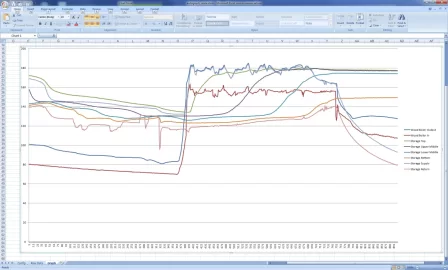- Nov 3, 2012
- 66
I initially installed my Attack DP35 Profi gassifier a couple of seasons ago, leaving my oil boiler for backup. Since I was not home during the day, I would have to overheat my home in the evening to hopefully get through the night, then let the oil boiler warm things in the morning, let the house cool through the day then repeat the process. This year I have added storage which helped, but until I automated things I had no idea how simple burning with solid fuel could be. My documentation is still a bit rough, so keep watching and I'll try to post as available to aid in understanding my system, which is fairly complex due to the number of heat loads, and admittedly because I an an engineer! The addition of storage helped, but I was finding it difficult to manage and had to spend a lot of time adjusting things as heat loads changed, etc. After a lot of research on what's available out there, I settled on a Vesta system from Vermont Energy Control Systems as my solution. (http://www.vecs.org). I now can light a fire and virtually ignore it until my system alerts me to add more wood, while gaining the best efficiency possible. I am using far less wood than I did without the controller and my house stays a constant temperature. I am using opposing circulators for charge/discharge of my storage, under control of the Vesta. What sets this apart from other systems I've looked at is the ability to add variable speed control to the circs under PID control. This enables me to not only control the charge cycle, but ensures that I don't starve the system, allowing the return temp to go too low, or keep the space heating zones from having sufficient energy (hydronic), or trying to heat the tank when there just isn't enough heat, causing destratification of the tank. I have learned that stratification is hugely important for efficiency and longevity of storage. The variable speed allows me to maintain an ideal delta T during tank charging, ensuring good stratificaiton and an efficient charge cycle. I typically see a delta T from the top of the tank to the bottom in the 50-60F range, with a dleta T at the FPX on the tank side in about the same range. By maintaining stratification, I am always drawing water from the bottom of the tank that is far colder than the top, improving the heat transfer function of the FPX. For the first time ever, I was able to load the boiler for a final burn last night, then go to bed, confident that the controller would do a good job of managing the heat and it was awesome! I am now truly, fossil free! The Vesta system made this very simple, as I was able to use all my existing hardware, including relays, etc. The built in PID functions coupled with the variable speed capability were essential and definitely make this a more hands off operation. One feature I really liked, but didn't fully appreciate until tuning my system, is the data logging and graphing. It makes it very simple to evaluate system performance and diagnose problems. It's very cool to see how your storage tank charge function behaves. In my case, I can watch each zone in the tank increase in temperature and was able to tune it so that each zone became fully charged before the next, maintaining excellent stratification. Programming is straight forward too - you don't need to be a computer geek to understand it. For anyone out there wanting a more automated system, I highly recommend this system.



